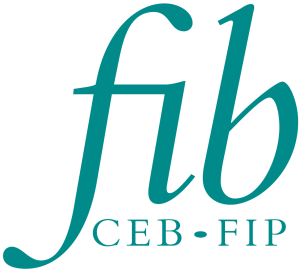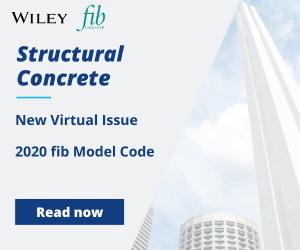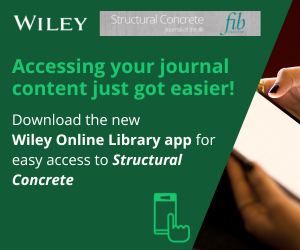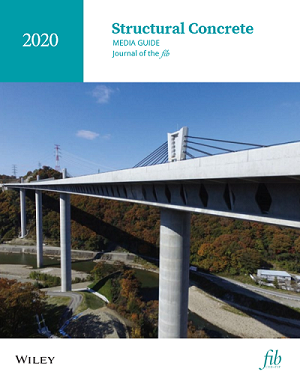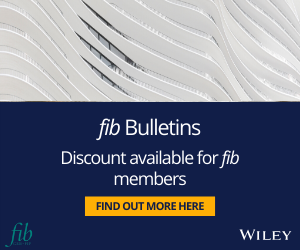Author Guidelines
Structural Concrete aims to foster inclusive science that publishes original papers on concrete and concrete structures. We seek to work with scholars from a range of institutional affiliations, nationalities, and career stages. We recognise that many groups are under-represented in research including women, people of colour, socially disadvantaged populations, national origins or other individual status. We encourage submissions from scholars who belong to groups which are often underrepresented.
Preparing a submission
New submissions should be made via the Article submission portal. For technical help with the submission system, please review our FAQs or contact s[email protected].
Manuscripts should be submitted with double line spacing and wide margins. The first page should include the full title of the paper and the full name(s) of the author(s), followed by their position held and the institution(s) where the work was done. The contact address, telephone number, and e-mail address of the lead author should also be supplied. Photographs of the author(s), clearly identified, should also be supplied.
Free Format submission
This journal offers Free Format submission for a simplified and streamlined submission process.
Before you submit, you will need:
- Your manuscript: this should be an editable file including text, figures, and tables, or separate files—whichever you prefer. All required sections should be contained in your manuscript, including abstract, introduction, methods, results, and conclusions. Figures and tables should have legends. Figures should be uploaded in the highest resolution possible. If the figures are not of sufficiently high quality your manuscript may be delayed. References may be submitted in any style or format, as long as it is consistent throughout the manuscript. Supporting information should be submitted in separate files. If the manuscript, figures or tables are difficult for you to read, they will also be difficult for the editors and reviewers, and the editorial office will send it back to you for revision. Your manuscript may also be sent back to you for revision if the quality of English language is poor.
- An ORCID ID, freely available at https://orcid.org. (Why is this important? Your article, if accepted and published, will be attached to your ORCID profile. Institutions and funders are increasingly requiring authors to have ORCID IDs.)
- All co-authors are required as mandatory to provide a profile picture of themselves using the ‘Author Picture’ article type in the submission portal at revision. Co-author brief biographies are also required and should be provided at the end of the main document file under an ‘Author Biographies’ section before the references. This information will be published with the article.
- The title page of the manuscript, including:
- Your co-author details, including affiliation and email address. (Why is this important? We need to keep all co-authors informed of the outcome of the peer review process.)
- Statements relating to our ethics and integrity policies, which may include any of the following (Why are these important? We need to uphold rigorous ethical standards for the research we consider for publication):
- data availability statement
- funding statement
- conflict of interest disclosure
- ethics approval statement
- patient consent statement
- permission to reproduce material from other sources
- clinical trial registration
Authorship
All listed authors should have contributed to the manuscript substantially and have agreed to the final submitted version. Review editorial standards and scroll down for a description of authorship criteria. For further information, please reference the COPE authorship discussion document.
Corresponding authors must use an official email address such as an institutional or company email (public email providers are not acceptable for corresponding authors) when registering to the submission system. Please avoid email providers such as Yahoo, Google or Microsoft as these sometimes block our emails. Make sure to enter the full and correct contact details of you and your co-authors.
If you are submitting a Short Project Note or Discussion Paper (see below for further details), please make that clear in your submission.
Article Types
Short Project Notes will be assigned by the Editor in Chief to a member of the Advisory Editorial Board, who will review the suitability of the proposal for publication and suggest any necessary revisions. Please refer clearly in the submission that this is a Short Project Note.
d. Special Issue Papers: Structural Concrete Special Issues operate on a ‘by-invitation-only’ basis. Unsolicited contributions, in principle, will not be considered. Full Special Issue instructions are available here.
Text Preparation
SI units should be used unless a paper describes a project which used imperial units, in which case these should be given and a table of the conversion factors supplied.
Mathematical expressions should be presented in clear form. Each equation should be typed on a separate line and be numbered consecutively. A notation should be provided on a separate sheet. Greek characters should be identified in the margin when they first occur. Matrix and vector quantities should be identified in the notation.
Preprint Policy
Structural Concrete will consider for review articles previously available as preprints. Authors may also post the submitted version of a manuscript to a preprint server at any time. Authors are requested to update any pre-publication versions with a link to the final published article.
Please find the Wiley preprint policy here.
LaTeX
Structural Concrete provides this LaTeX class file which simulates the appearance of the typeset journal page (located here), and authors are encouraged to use this, although other class files can also be accepted.
Authors of accepted manuscripts should supply the following files for typesetting:
(i) The LaTeX source code (text, figure captions and tables, preferably in a single file), along with all other files needed for compiling. This is particularly important if authors have used any LaTeX style or class files, bibliography files (.bbl, .bst. .blg) apart from those used in the journal’s class file. Author-defined macros should be kept to a minimum or avoided wherever possible.
(ii) Electronic graphics files for the illustrations in Encapsulated PostScript (EPS), PDF or TIFF format. Authors are requested not to create figures using LaTeX codes.
This template helps authors use standard Latex coding for optimal conversion to typeset specifications of journals in New Journal Design. Please avoid using custom fonts or customized layouts, complex constructions, and macros. Our typesetters convert all manuscripts into final files during the production process which are used for publication. The use of customized layouts or fonts or macros could make the conversion process unpredictable.
Figures
Only those drawings and photographs essential to the understanding of the text should be included. It is essential that the original artwork files are supplied as individual files. Figures should be referred to in the text and listed on a separate sheet in the order in which they appear.
Figures must be a minimum of 600 dots per inch (dpi) for line drawings and 300 dpi for all other images. Photographs must be of good quality with sharp focus and clear definition. Photographs must be supplied as tif, jpg or eps format. The width of the image should be at least 1500 pixels or ‘dots’, using a digital camera setting of 1500 x 1000 pixels or scanning a 150 x 100 mm print or drawing at a resolution of at least 300 dpi.
Tables
Tables should be numbered consecutively and referred to in the text. They should not duplicate information already given in the text nor contain material which would be better presented graphically. Tabular matter should be as simple as possible, with brief column headings and a minimum number of columns.
Supporting Information
Supporting information is information that is not essential to the article, but provides greater depth and background. It is hosted online and appears without editing or typesetting. It may include tables, figures, videos, datasets, etc.
Click here for Wiley’s FAQs on supporting information. Note: if data, scripts, or other artefacts used to generate the analyses presented in the paper are available via a publicly available data repository, authors should include a reference to the location of the material within their paper.
Reference Style
This journal uses Vancouver reference style. Review your reference style guidelines prior to submission. As this journal offers Free Format submission, however, this is for information only and you do not need to format the references in your article. This will instead be taken care of by the typesetter.
Article Preparation Support
Wiley Editing Services offers expert help with English Language Editing, as well as translation, manuscript formatting, figure illustration, figure formatting, and graphical abstract design – so you can submit your manuscript with confidence. Also, check out our resources for Preparing Your Article for general guidance about writing and preparing your manuscript.
Data Sharing and Availability
Please review Wiley's policy here. This journal expects data sharing.
The journal expects authors to share the data and other artefacts supporting the results in the paper by archiving it in an appropriate public repository. Authors should include a data accessibility statement, including a link to the repository they have used, in order that this statement can be published alongside their paper.
Author Licensing
If a paper is accepted for publication, the author identified as the formal corresponding author will receive an email prompting them to log in to Author Services, where via the Wiley Author Licensing Service (WALS) they will be required to complete a copyright license agreement on behalf of all authors of the paper.
Authors may choose to publish under the terms of the journal’s standard copyright agreement, or OnlineOpen under the terms of a Creative Commons License. General information regarding licensing and copyright is available here.
If the OnlineOpen option is not selected the corresponding author will be presented with the copyright transfer agreement (CTA) to sign. The most recent version of the CTA can be found here along with the terms and conditions.
To review the Creative Commons License options offered under OnlineOpen, please click here. (Note that certain funders mandate a particular type of CC license be used; to check this please click here.)
Self-Archiving Definitions and Policies: Note that the journal’s standard copyright agreement allows for self-archiving of different versions of the article under specific conditions. Please click here for more detailed information about self-archiving definitions and policies.
Open Access fees: Authors who choose to publish using OnlineOpen will be charged a fee. A list of Article Publication Charges for Wiley journals is available here. For more information on this journal’s APCs, please see the Open Access page.
Funder Open Access: Please click here for more information on Wiley’s compliance with specific Funder Open Access Policies.
Article Promotion Support
Wiley Editing Services offers professional video, design, and writing services to create shareable video abstracts, infographics, conference posters, lay summaries, and research news stories for your research – so you can help your research get the attention it deserves.
Author Name Change Policy
In cases where authors wish to change their name following publication, Wiley will update and republish the paper and redeliver the updated metadata to indexing services. Our editorial and production teams will use discretion in recognizing that name changes may be of a sensitive and private nature for various reasons including (but not limited to) alignment with gender identity, or as a result of marriage, divorce, or religious conversion. Accordingly, to protect the author’s privacy, we will not publish a correction notice to the paper, and we will not notify co-authors of the change. Authors should contact the journal’s Editorial Office with their name change request.




